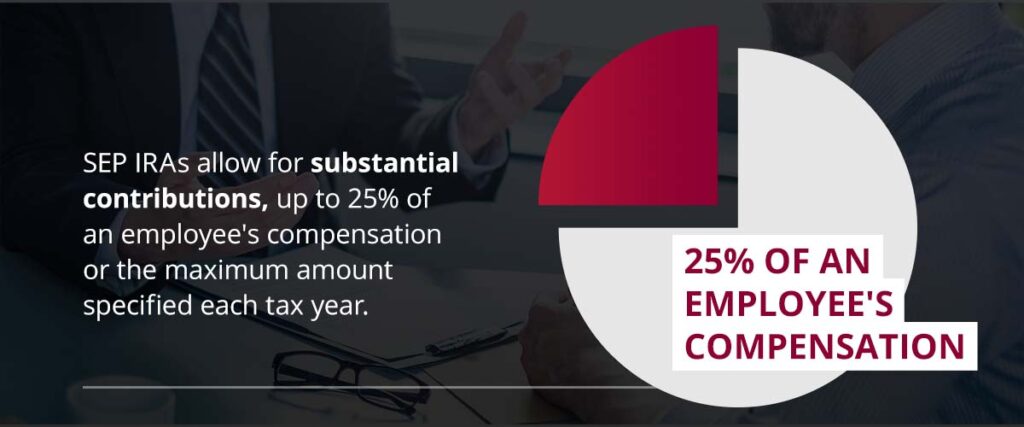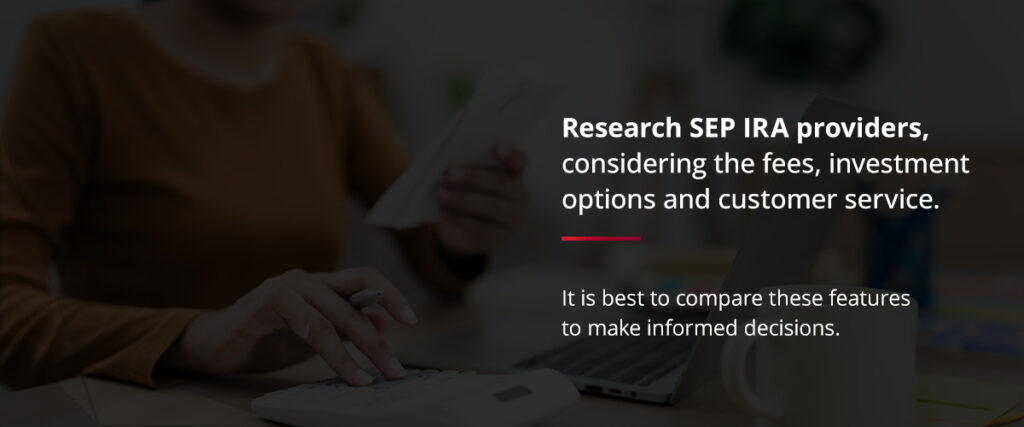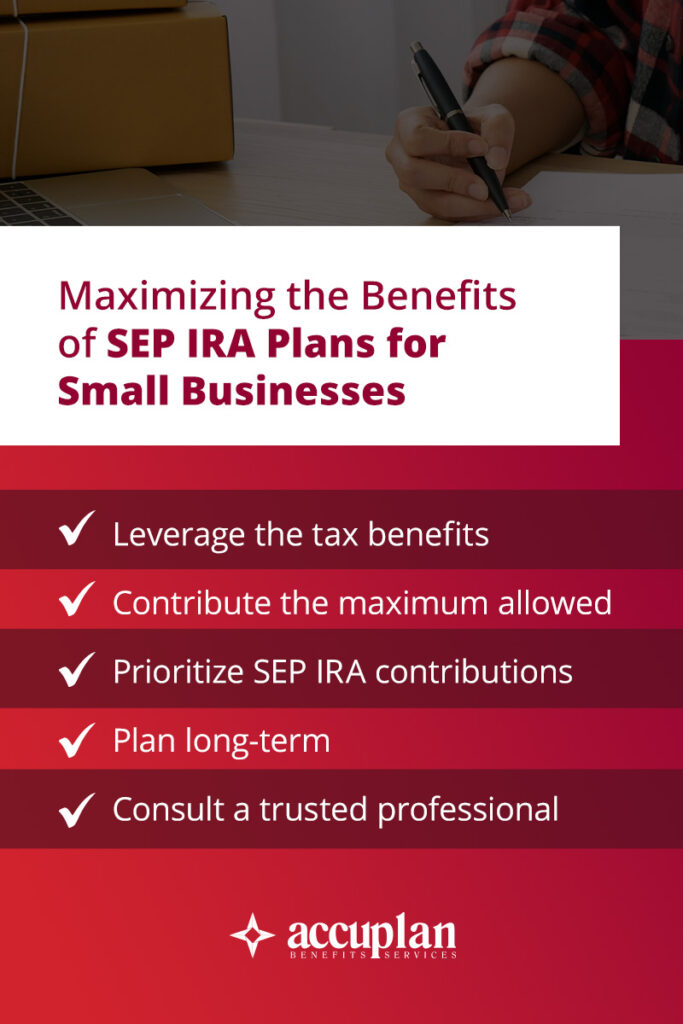
As a self-employed individual or small business owner, you have several retirement plan options. One example is a Simplified Employee Pension Individual Retirement Account (SEP IRA). This account has unique features that can help you maximize tax savings. You can also create a self-directed SEP IRA, which lets you invest beyond traditional assets like stocks and bonds.
This guide discusses SEP IRAs, their benefits and the rules. You will also learn how to open an account with Accuplan Benefits Services, which is relatively simple.
What Is a SEP IRA?
A SEP IRA is a retirement plan designed for self-employed individuals or small business owners. It allows you to contribute funds to your retirement savings account while reducing your taxable income. Employers can deduct contributions made to their accounts or that of their employees. SEP IRAs appeal to many business owners because they are easy to set up and maintain. They also offer high contribution limits compared to conventional IRAs.
Benefits of SEP IRA Plans for Small Business Owners
SEP IRAs appeal to most business owners because of their numerous advantages. Here is a detailed exploration of the key factors:
1. Tax Advantages for Small Business Owners
SEP IRAs have many tax benefits, including the following:
- Tax-deductible contributions: Contributions made to a SEP IRA are tax-deductible for businesses. The amount you contribute reduces your taxable income, resulting in lower tax liability. This feature can provide significant tax savings.
- Tax-deferred growth: Investments within a SEP IRA grow tax-deferred. You and your employees do not pay tax earnings until withdrawals, typically in retirement. This deferral allows for compounded growth over time, enhancing retirement savings.
- Potential for high contributions: SEP IRAs allow for substantial contributions, up to 25% of an employee’s compensation or the maximum amount specified each tax year. This contribution limit exceeds traditional and Roth IRAs, which increases savings potential.

- No FICA taxes on contributions: Unlike wages, contributions to a SEP IRA are not subject to the Federal Insurance Contributions Act (FICA) or Social Security and Medicare taxes, enhancing tax efficiency.
2. Simplified Setup and Administration Process
Setting up a SEP IRA is straightforward and involves minimal paperwork. You can establish a SEP IRA through financial institutions or specialized companies like Accuplan Benefits Services. You only need to complete a form and provide some valuable information. However, it is crucial to comply with the eligibility requirements.
Once established, SEP IRAs require little ongoing administrative work compared to other retirement plans, such as 401(k)s. There are no annual filing requirements with the IRS, reducing administrative burden and associated costs. This simplicity makes it particularly attractive for small businesses lacking the resources for complex plan management.
3. Flexibility in Contribution Limits for Varying Income Levels
Contributions are not required each year, allowing you to adjust based on your financial situation. You can contribute the maximum allowable amount during profitable years and reduce or contribute nothing during lean years. Contributing a substantial portion of your income allows for aggressive retirement savings.
If you decide to offer a SEP IRA, eligible employees must receive contributions at the same percentage of their salary. This arrangement fosters a sense of equality and inclusivity within the company. Employee satisfaction can also increase your retention rate.
Who Can Contribute to a SEP IRA?
Any employer with one or more employees, including a nonprofit organization, sole proprietorship, partnership or corporation, may establish a SEP plan. This includes self-employed business owners, regardless of whether they are the only employees of the business. Individual employees may not establish a SEP plan. Generally, a traditional IRA that receives SEP-employer contributions is treated as a SEP IRA and labeled as such by the custodian.
SEP IRA contributions must be made by the due date of the employer’s tax return, including extensions. SEP IRA contributions are reported on Form 5498 in the calendar year in which they are received. Your tax form may reflect current and previous year contributions if both were received in the same calendar year. Consult tax professionals for more information and to familiarize yourself further with SEP IRAs.
Special Considerations for Partnership Structures
Partners considering SEP IRAs should note certain key factors, including the following:
- Partners as employees: In a partnership, each partner may be considered an employer or employee for varying purposes. This unique structure allows partners to contribute to the SEP IRA based on their partnership income.
- Contribution calculation: Partners can contribute up to 25% of their net earnings from self-employment. The calculation usually involves deducting half of their self-employment taxes and other business expenses from their gross income.
- Equal contribution requirements: All partnership employees, including the partners, must receive contributions at the same percentage of their salaries. This requirement ensures fairness and compliance with IRS regulations.
- Member contributions in an LLC: For an LLC treated as a partnership, members can also contribute to their SEP IRAs based on their distributive share of the LLC’s income. The contribution rules are similar to those for partners in a traditional partnership.
Determining Employee Participation and Inclusion Requirements
Employees must meet specific eligibility criteria to participate in SER IRA. These requirements include:
- Age: An employee must be at least 21 years old to participate in SEP IRA.
- Service duration: Generally, the employee must have worked for the business for at least three of the last five years.
- Employment type: Eligible employees must participate, including part-time and seasonal workers and employees who terminated employment or passed away during the year.
- Minimum compensation: Your SEP may also cover employees who received compensation of less than $750 during the year, but there is no requirement. The amount is subject to cost-of-living adjustments.
Remember, you must include all eligible employees in the plan once you establish the SEP IRA. You cannot selectively exclude any employee based on their duration of service or compensation levels.
Setting up a SEP IRA Account for Your Small Business
Establishing a SEP IRA for a partnership or other small business is straightforward. However, you must carefully plan and execute to comply with the IRS regulations. Here is a step-by-step guideline:
1. Determine Eligibility
Confirm that your business meets the eligibility requirements for establishing a SEP IRA. Also, check which employees qualify, considering the age and service requirements.
2. Choose a SEP IRA Provider

Research SEP IRA providers, considering the fees, investment options and customer service. It is best to compare these features to make informed decisions.
3. Prepare a SEP IRA Plan Document
Create a written SEP plan outlining the terms. Some providers have model plan documents, but you can also use the IRS model SEP plan called Form 5305-SEP.
4. Notify Eligible Employees
Inform all eligible employees about the plan. They should also have access to the policy to know the contribution percentage and their rights under the plan.
5. Open SEP IRA Accounts for Owners and Employees
Each eligible owner and employee must open an individual SEP IRA account with the chosen provider, which typically involves completing an application form and providing the necessary information.
6. Make Contributions
Contribute to accounts according to the percentage specified in your policy. Remember, contributions must be uniform across all eligible employees. You can review the plan annually and adjust contributions based on the business’s financial situation.
7. Maintain Plan Compliance
Keep records of contributions, plan documents and notifications provided to employees. While SEP IRAs have minimal reporting requirements, maintaining accurate records is essential for compliance.
Maximizing the Benefits of SEP IRA Plans for Small Businesses
Developing strategies based on your needs and financial situation can help you maximize the benefits of having a SEP IRA. Here are some tips to consider:

- Leverage the tax benefits: Deduct contributions from business income to reduce your taxable income. This strategy can increase tax savings. You should also limit withdrawals to allow contributions to grow tax-deferred.
- Contribute the maximum allowed: Take advantage of the high contribution limits by contributing the maximum allowable percentage of employee compensation. That can boost savings and increase your tax deductibles.
- Prioritize SEP IRA contributions: Make SEP IRA contributions a top financial focus, especially during profitable years. This proactive approach helps you prioritize retirement savings over expenses.
- Plan long-term: Develop a long-term SEP IRA contribution plan that aligns with your retirement goals. This plan should consider the desired retirement age, income needs and investment growth projections.
- Consult a trusted professional: Seek guidance from a qualified financial advisor who can help optimize your SEP IRA contributions. They can also guide you in developing a retirement savings strategy.
Common Questions About Small Business SEP IRAs
Here are answers to some frequently asked questions:
Can a Self-Employed Individual Open a SEP IRA?
Yes, a self-employed individual can open a SEP IRA. These accounts are primarily designed to accommodate self-employed individuals, sole proprietors and small business owners.
What Happens to a SEP IRA When a Partnership Dissolves?
Generally, the treatment of a SEP IRA upon dissolution depends on the provisions of the partnership agreement. The specific actions taken by the partners also matter. Here are some key considerations:
- Individual accounts: Funds in the accounts belong to the partners and employees and are not directly affected by the dissolution.
- Possible tax implications: Partners who withdraw funds during the dissolution process may incur taxes and penalties on distributions.
- Plan continuation: Partners who continue individual businesses may keep the SEP IRA active and contribute as allowed.
How Does a SEP IRA Compare to Other Business Retirement Accounts?
SEP IRAs have distinct features that differ from other business retirement accounts like 401(k) plans and SIMPLE IRAs. For example, while SEP IRAs are designed for self-employed individuals and small businesses, any business, including large corporations, can establish 401(k) plans. SIMPLE IRAs are designed for employers with 100 or fewer employees. There are also differences in contribution limits, employer contributions and administrative burden.
Open a SEP IRA Account at Accuplan Benefits Services

Accuplan Benefits Services allows you to do more with your retirement savings. With a self-directed SEP IRA, you can invest beyond traditional options like stocks and bonds. It gives you greater control over your retirement account and enables you to invest in a wide range of assets, like private equity, real estate, cryptocurrencies and precious metals.
Do you want to learn more? Contact us now!
Our information shouldn’t be relied upon for investment advice but simply for information and educational purposes only. It is not intended to provide, nor should it be relied upon for accounting, legal, tax or investment advice.